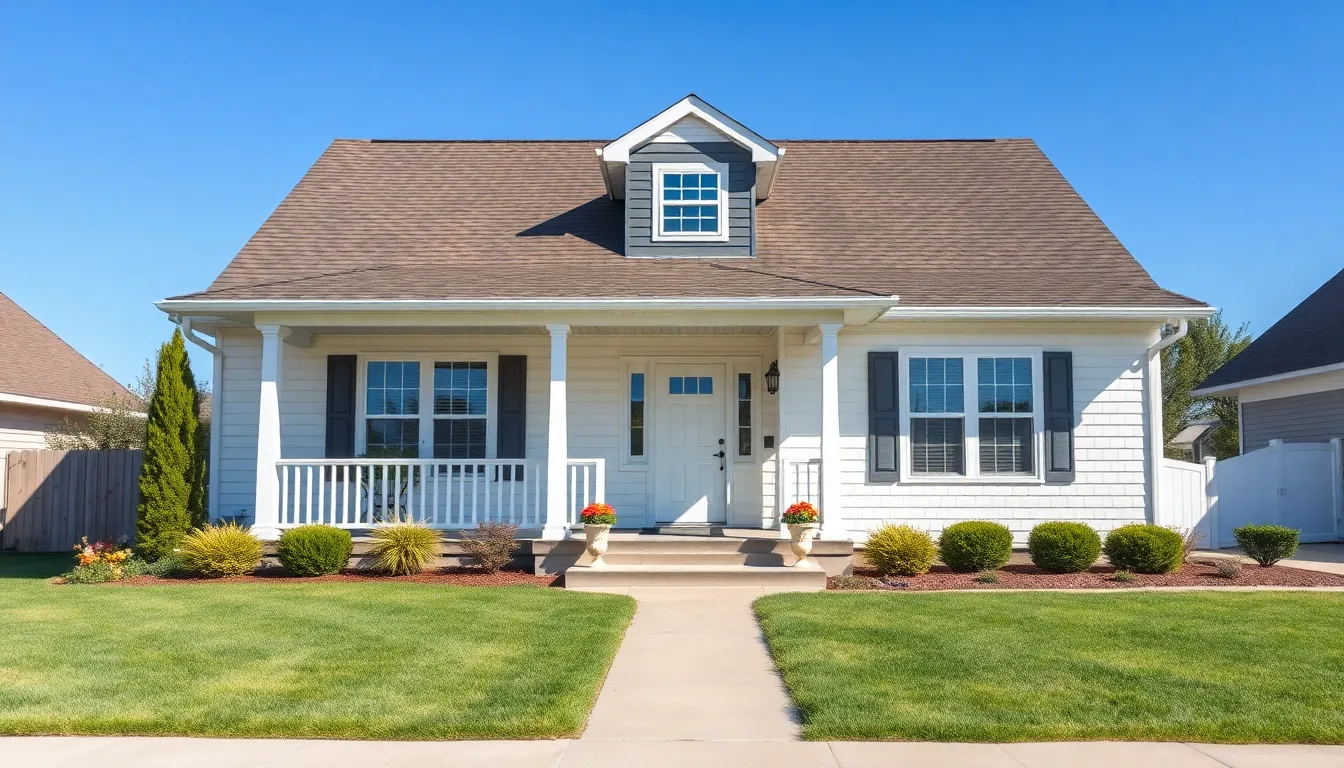Homeownership brings joy and a sense of security, but it also comes with risks. From natural disasters to unexpected accidents, the potential for loss is ever-present. That’s where necessary home insurance steps in, offering protection that every homeowner should consider essential.
Without the right coverage, a single event could lead to devastating financial consequences. Home insurance not only safeguards the physical structure of a home but also protects personal belongings and liability against accidents. Understanding the different types of coverage available can empower homeowners to make informed decisions that best fit their needs. In a world full of uncertainties, having the right home insurance isn’t just a choice—it’s a necessity.
Table of Contents
ToggleUnderstanding Necessary Home Insurance
Home insurance serves as a vital safety net for homeowners, protecting against unforeseen events that could lead to substantial financial losses. Understanding its importance and types of coverage ensures informed decisions regarding protection.
Importance of Home Insurance
Home insurance protects the homeowner’s investment, covering damages caused by events such as fires, thefts, and natural disasters. With the potential for repair costs and replacement expenses reaching thousands of dollars, having insurance alleviates financial burdens. Additionally, home insurance offers liability protection, covering legal expenses if someone gets injured on the property. This comprehensive safety measure fosters peace of mind, knowing that financial security exists in the face of unexpected circumstances.
Types of Home Insurance Coverage
Home insurance typically includes several types of coverage:
- Dwelling Coverage: Protects the home’s structure against damages from incidents like fire, wind, or vandalism.
- Personal Property Coverage: Insures personal belongings inside the home, covering loss or damage due to theft or disasters.
- Liability Coverage: Offers financial protection against lawsuits for injuries that occur on the property.
- Additional Living Expenses (ALE) Coverage: Covers costs incurred if a homeowner needs to live elsewhere while the home undergoes repairs due to a covered event.
Evaluating these coverage types helps homeowners choose policies that best fit their unique situations and risks.
Key Components of a Home Insurance Policy

Home insurance includes several key components, each essential to ensuring comprehensive protection for homeowners. Understanding these components enables informed decisions regarding suitable coverage options.
Dwelling Coverage
Dwelling Coverage protects the physical structure of a home, including walls, roof, and built-in appliances. It covers damages from perils such as fire, windstorm, and vandalism. Typically, policies provide coverage based on the home’s replacement cost value, allowing for adequate funding to repair or rebuild in case of loss.
Personal Property Coverage
Personal Property Coverage safeguards belongings inside the home, including furniture, electronics, and clothing. This coverage applies to damages resulting from incidents like theft, fire, or water damage. It often includes coverage for valuable items, such as jewelry and artwork, with specific limits; it’s crucial to document valuable possessions to ensure appropriate reimbursement during claims.
Liability Protection
Liability Protection covers the homeowner against claims resulting from injuries or property damage sustained by others on their property. This coverage includes legal expenses, medical bills, and potential settlements or judgments. Homeowners benefit significantly from liability protection, especially if hosting guests or engaging in outdoor activities that may pose risks.
Assessing Your Home Insurance Needs
Evaluating home insurance needs involves understanding various factors and determining the appropriate coverage amount. Homeowners should consider personal circumstances and property specifics to ensure adequate protection.
Factors to Consider
- Home Value: Assess the current market value of the home. Insurance should reflect the cost to rebuild, not just market sale value.
- Location: Consider risks associated with the home’s geographical area, including natural disasters, crime rates, and proximity to emergency services.
- Personal Property: Inventory valuable items and belongings to estimate the necessary personal property coverage. This includes furniture, electronics, and collectibles.
- Liability Risks: Evaluate how often the property is used for social gatherings or activities that could increase liability risks, impacting the need for liability protection.
- Replacement Costs: Understand the difference between replacement cost and actual cash value. Replacement cost covers full repair or replacement without depreciation.
- Home Improvements: Factor in any renovations or upgrades. Increased home value from improvements often necessitates additional coverage.
- Deductibles: Decide on an acceptable deductible amount, which affects premium costs. Higher deductibles lead to lower premiums but increase out-of-pocket expenses during a claim.
How to Determine Coverage Amount
- Replacement Cost Estimate: Obtain a replacement cost estimate from a professional to accurately value the home and its contents.
- Inventory Documentation: Create a detailed inventory of personal belongings with purchase dates, values, and photographs. This documentation assists in selecting coverage limits.
- Consulting Professionals: Seek guidance from a licensed insurance agent or financial advisor. They can provide insights tailored to specific needs and local market conditions.
- Regular Review: Reassess coverage amounts regularly, especially after significant purchases, renovations, or changes in lifestyle. Annual reviews keep policies aligned with current circumstances.
- Comparative Analysis: Compare coverage options and quotes from multiple insurance providers. This helps identify the best insurance policy that meets coverage needs and budget.
Understanding these factors and methods helps homeowners make informed decisions about necessary home insurance, ensuring adequate coverage for their unique situations.
Common Exclusions in Home Insurance
Home insurance policies contain specific exclusions that homeowners must understand. Awareness of these limitations helps homeowners avoid unexpected gaps in coverage.
Understanding Policy Limitations
Home insurance policies outline critical limitations. Homeowners face restrictions on coverage amounts, specific disaster events, and policy conditions. For example, named perils policies cover only listed risks, while all-risk policies cover everything not explicitly excluded. Homeowners should read their policy documents carefully and clarify any uncertainties with the insurer.
What Isn’t Covered?
Common exclusions in home insurance include:
- Flood damage: Most standard policies do not cover flood-related losses. Homeowners must seek separate flood insurance to protect against this risk.
- Earthquake damage: Earthquake damage generally falls outside the typical policy scope. In earthquake-prone areas, additional policies may provide needed coverage.
- Maintenance issues: Wear and tear, pest infestations, and neglect-related damages typically aren’t insured. Homeowners are responsible for regular maintenance and repairs.
- High-value items: Jewelry, art, and collectibles often require specific endorsements to ensure proper coverage. Standard personal property limits may not cover these items adequately.
- Intentional damage: Damage caused intentionally by homeowners or their guests isn’t covered. Insurance companies may deny claims associated with deliberate acts.
- Business activities: Home-based businesses usually lack coverage under personal policies. Business owners should secure commercial insurance for business-related risks.
Understanding these exclusions allows homeowners to evaluate their needs more accurately and seek supplemental coverage where necessary.
Tips for Choosing the Right Provider
Selecting the right insurance provider requires careful consideration and research. Homeowners should focus on comparing quotes and evaluating customer feedback to make well-informed decisions.
Comparing Insurance Quotes
Comparing insurance quotes helps homeowners identify suitable coverage options at competitive prices. Homeowners should:
- Gather quotes from at least three different providers to ensure a comprehensive comparison.
- Assess coverage limits and deductibles to understand how each policy aligns with personal needs.
- Pay attention to discounts offered for bundling policies or maintaining a claims-free history.
- Consider customer service reputation, as effective communication can significantly impact policy administration.
Reading Customer Reviews
- Look for feedback on claim processes, as positive experiences may indicate efficient handling procedures.
- Seek out reviews on overall customer service, which helps gauge provider responsiveness and support.
- Evaluate ratings on platforms like the Better Business Bureau or Trustpilot for objective assessments.
- Notice patterns in complaints or praises to identify potential issues or strengths within providers.
Home insurance stands as a crucial element for any homeowner looking to protect their investment. By understanding the various types of coverage and assessing individual needs, homeowners can ensure they select the right policy. This not only safeguards their property but also provides peace of mind against unforeseen events.
With the right home insurance in place, they can navigate the complexities of homeownership with confidence. It’s essential to stay informed about coverage options and exclusions to avoid unexpected gaps. Ultimately, making informed choices about home insurance can significantly mitigate financial risks and enhance overall security in an unpredictable world.



